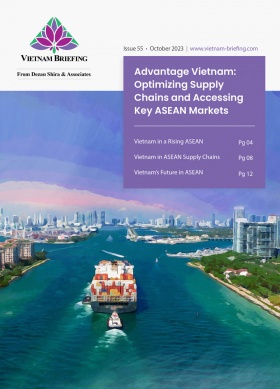Shrimp Farming in Vietnam: Opportunities for Foreign Firms
Despite their small size, shrimp have become big business in Vietnam. In this article, we take a broad overview of the sector and where foreign investors may find the most lucrative opportunities.
Vietnam has become the world’s second-largest shrimp supplier, accounting for 13 to 14 percent of overall shrimp exports. Vietnamese shrimp products have been exported to approximately 100 countries, with five key markets, including Europe, the United States, Japan, China, and Korea.
Furthermore, according to the most recent statistics from the Ministry of Agriculture and Rural Development’s Department of Fisheries, Vietnam’s shrimp export turnover achieved a record US$4.3 billion last year, an increase of 11.2 percent over 2021.
These numbers serve to highlight that this is a profitable industry, and it has the potential to grow even further with the right investment in the right places. It’s with this in mind, that the Vietnam Briefing looks at options for foreign investors in the shrimp market in Vietnam today.
Opportunities to invest in Vietnam’s shrimp industry
Although Vietnam is a major shrimp exporter, its competitiveness is still low due to a lack of efficiency in its operations, including a lack of technology but also shrimp farming and processing skills. This may provide an opening for foreign firms in the seafood farming or processing industry in several areas.
Technology
Purchasing modern equipment and machinery is one solution for businesses to increase output. It not only helps to minimize manufacturing costs by saving time, but it also helps to boost productivity and the quality of products. In this respect, firms providing machinery and equipment for use in shrimp farming may find a lucrative market in Vietnam.
Microbial products can also vastly reduce wastage in shrimp farming; however, these are currently in limited use in Vietnam due to capital constraints. Foreign firms that choose to invest in the sector may consider utilizing microbial products to boost the return on their investment.
Scaling local shrimp farms
Foreign firms may be able to generate significant profits by investing in scaling up local shrimp farming operations.
Vietnam is still far behind in building high-quality, large-scale shrimp farms. The majority of shrimp farms in Vietnam are small and densely packed. Due to a shortage of capital, shrimp farming facilities use traditional production methods without automation, resulting in inconsistent shrimp quality across regions.
For example, despite the fact that Ca Mau is the country’s leading province in terms of shrimp farming area, the bulk of shrimp farming homes here are small and fragmented, and water infrastructure conditions are inadequate. As a result, farming output is inconsistent.
In this light, foreign firms may find that by investing in local shrimp farms and upgrading their infrastructure, they may be able to improve productivity and profits.
Irrigation systems
Another attractive investment option for foreign enterprises is the supply of filters and aerators, and drainage and water delivery systems. Constructing these systems in conjunction with a conventional waste treatment device is thought to be one of the keys to slowing the pace of disease transmission among shrimp.
According to Luan Dinh Tran, General Director of the Directorate of Fisheries, investing in irrigation systems is an essential need for the shrimp industry’s development and a long-term need for this billion-dollar industry to develop safely and effectively
Certifications
Vietnamese shrimp are turned into a variety of products for consumers by an advanced processing industry. This includes both fresh and dried shrimp but also a range of products in between. These products have received major international certifications, such as ASC, GlobalG.A.P, Naturland, and BAP. As a result, the value of Vietnamese shrimp is increasing.
Free trade agreements (FTAs)
Free trade agreements have helped Vietnam export shrimp to more than 100 countries. These agreements are advantageous and can increase revenue and profits for companies investing in Vietnam’s shrimp industry.
In particular, the EVFTA agreement and the high processing standards it demands have helped boost Vietnamese shrimp sales to the EU. This includes both the quantity consumed and their value.
The UKVFTA has also allowed Vietnamese shrimp to enjoy favorable import tariffs to the UK. In fact, said tariffs have been slashed from 10 to 20 percent to 0 percent if their Vietnamese origin can be demonstrated.
Looking ahead
Although Vietnam’s shrimp sector continues to confront many hurdles, those issues also present many opportunities for foreign companies. Investors can profit from existing industry shortages as well as benefit from Vietnam’s many trade agreements.
Furthermore, by studying the market in-depth and employing rigorous planning, investors in, and suppliers to, Vietnam’s shrimp industry may find a lucrative market in this rapidly developing nation.
For more information, contact the business advisory experts at Dezan Shira and Associates.
About Us
Vietnam Briefing is published by Asia Briefing, a subsidiary of Dezan Shira & Associates. We produce material for foreign investors throughout Eurasia, including ASEAN, China, India, Indonesia, Russia & the Silk Road. For editorial matters please contact us here and for a complimentary subscription to our products, please click here.
Dezan Shira & Associates provide business intelligence, due diligence, legal, tax and advisory services throughout the Vietnam and the Asian region. We maintain offices in Hanoi and Ho Chi Minh City, as well as throughout China, South-East Asia, India, and Russia. For assistance with investments into Vietnam please contact us at vietnam@dezshira.com or visit us at www.dezshira.com
- Previous Article Vietnam’s Strategy to Attract and Develop Talent
- Next Article Providing Security Services in Vietnam for Foreign Firms





